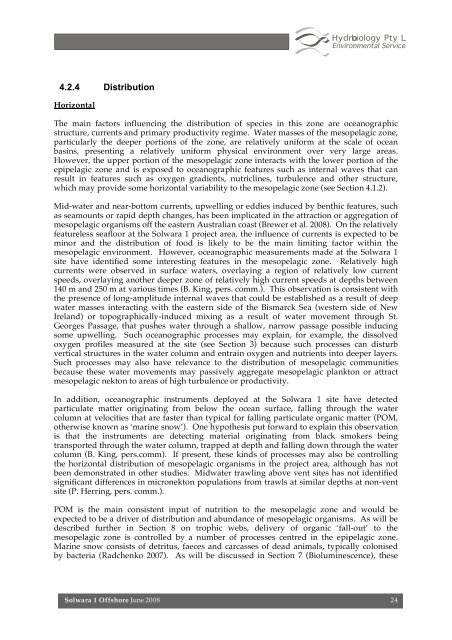Appendices 5-13 - Nautilus Cares - Nautilus Minerals
Appendices 5-13 - Nautilus Cares - Nautilus Minerals
Appendices 5-13 - Nautilus Cares - Nautilus Minerals
Create successful ePaper yourself
Turn your PDF publications into a flip-book with our unique Google optimized e-Paper software.
4.2.4 Distribution<br />
Horizontal<br />
Solwara 1 Offshore June 2008<br />
Hydrobiology Pty Ltd<br />
Environmental Services<br />
The main factors influencing the distribution of species in this zone are oceanographic<br />
structure, currents and primary productivity regime. Water masses of the mesopelagic zone,<br />
particularly the deeper portions of the zone, are relatively uniform at the scale of ocean<br />
basins, presenting a relatively uniform physical environment over very large areas.<br />
However, the upper portion of the mesopelagic zone interacts with the lower portion of the<br />
epipelagic zone and is exposed to oceanographic features such as internal waves that can<br />
result in features such as oxygen gradients, nutriclines, turbulence and other structure,<br />
which may provide some horizontal variability to the mesopelagic zone (see Section 4.1.2).<br />
Mid-water and near-bottom currents, upwelling or eddies induced by benthic features, such<br />
as seamounts or rapid depth changes, has been implicated in the attraction or aggregation of<br />
mesopelagic organisms off the eastern Australian coast (Brewer et al. 2008). On the relatively<br />
featureless seafloor at the Solwara 1 project area, the influence of currents is expected to be<br />
minor and the distribution of food is likely to be the main limiting factor within the<br />
mesopelagic environment. However, oceanographic measurements made at the Solwara 1<br />
site have identified some interesting features in the mesopelagic zone. Relatively high<br />
currents were observed in surface waters, overlaying a region of relatively low current<br />
speeds, overlaying another deeper zone of relatively high current speeds at depths between<br />
140 m and 250 m at various times (B. King, pers. comm.). This observation is consistent with<br />
the presence of long-amplitude internal waves that could be established as a result of deep<br />
water masses interacting with the eastern side of the Bismarck Sea (western side of New<br />
Ireland) or topographically-induced mixing as a result of water movement through St.<br />
Georges Passage, that pushes water through a shallow, narrow passage possible inducing<br />
some upwelling. Such oceanographic processes may explain, for example, the dissolved<br />
oxygen profiles measured at the site (see Section 3) because such processes can disturb<br />
vertical structures in the water column and entrain oxygen and nutrients into deeper layers.<br />
Such processes may also have relevance to the distribution of mesopelagic communities<br />
because these water movements may passively aggregate mesopelagic plankton or attract<br />
mesopelagic nekton to areas of high turbulence or productivity.<br />
In addition, oceanographic instruments deployed at the Solwara 1 site have detected<br />
particulate matter originating from below the ocean surface, falling through the water<br />
column at velocities that are faster than typical for falling particulate organic matter (POM,<br />
otherwise known as ‘marine snow’). One hypothesis put forward to explain this observation<br />
is that the instruments are detecting material originating from black smokers being<br />
transported through the water column, trapped at depth and falling down through the water<br />
column (B. King, pers.comm). If present, these kinds of processes may also be controlling<br />
the horizontal distribution of mesopelagic organisms in the project area, although has not<br />
been demonstrated in other studies. Midwater trawling above vent sites has not identified<br />
significant differences in micronekton populations from trawls at similar depths at non-vent<br />
site (P. Herring, pers. comm.).<br />
POM is the main consistent input of nutrition to the mesopelagic zone and would be<br />
expected to be a driver of distribution and abundance of mesopelagic organisms. As will be<br />
described further in Section 8 on trophic webs, delivery of organic ‘fall-out’ to the<br />
mesopelagic zone is controlled by a number of processes centred in the epipelagic zone.<br />
Marine snow consists of detritus, faeces and carcasses of dead animals, typically colonised<br />
by bacteria (Radchenko 2007). As will be discussed in Section 7 (Bioluminescence), these<br />
24


